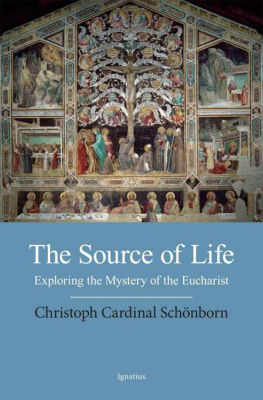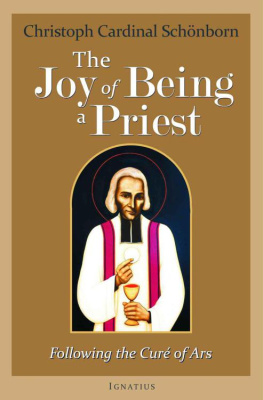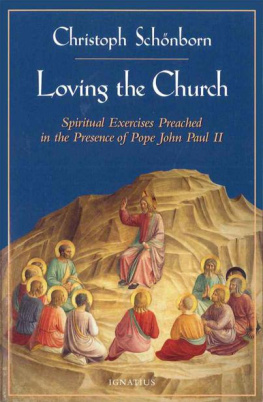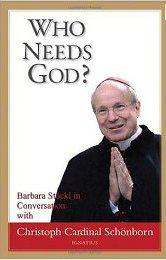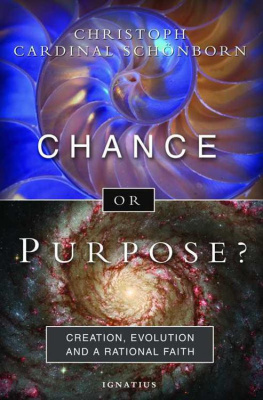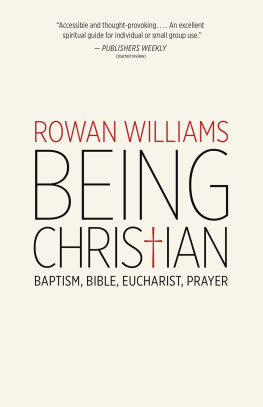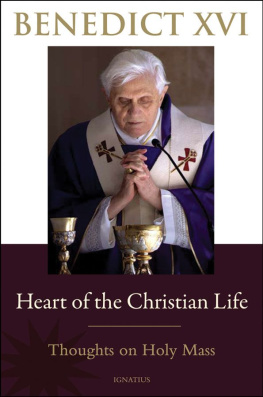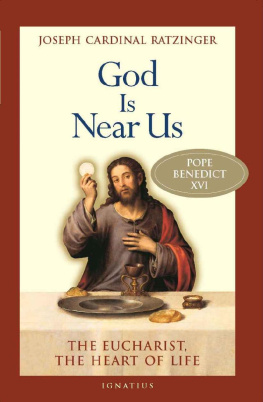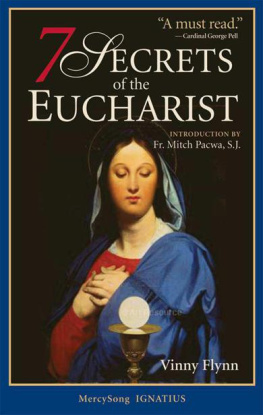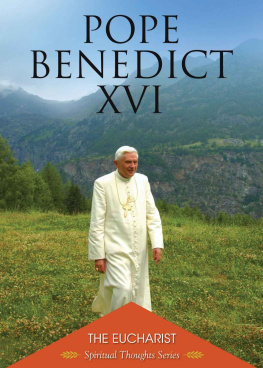THE SOURCE OF LIFE
CHRISTOPH CARDINAL SCHNBORN
THE SOURCE
OF LIFE
Exploring the Mystery of the Eucharist
Edited by Hubert Philipp Weber
Translated by Brian McNeil
IGNATIUS PRESS SAN FRANCISCO
Original German edition
Wovon wir leben knnen: Das Geheimnis der Eucharistie
Edited by Hubert Philipp Weber
2005 by Verlag Herder GmbH, Freiburg im Breisgau, Germany
English language edition
2007 by The Crossroad Publishing Company, New York, NY
All rights reserved
Biblical translations are taken from the Revised Standard Version
1973 by the Division of Christian Education of the National
Council of the Churches of Christ in the United States of America.
Cover art:
The Tree of Life and Last Supper
Taddeo Gaddi (c. 1300-1366)
Fresco. Former Refectory. Museo dellOpera, S. Croce
Florence, Italy
Photograph: Raffaello Bencini
Alinari / Art Resource, New York
Cover design by Roxanne Mei Lum
Published 2013 by Ignatius Press, San Francisco
By arrangement with The Crossroad Publishing Company
ISBN 978-1-58617-784-3
Library of Congress catalogue number 2013930748
Printed in the United States of America
CONTENTS
A Precious Treasure in Earthen VesselsThe Last Supper and the Old TestamentThe Jewish Prayer of Praise and ThanksgivingPraise in Daily LifeA Chosen People, a Royal Priesthood
The Last SupperA Passover MealThe Breaking of the BreadPrayers of ThanksgivingA Meal, and More Than a Meal
General IssuesSymbolic and Real Actions: This Is My BodyMy Blood, the Blood of the CovenantNot to Be Taken for Granted
RemembranceThe Past Becomes PresentRecalling in a Double SenseThe Eucharist in the Early Church
The Liturgy of the ChurchSacrifice in the Third Eucharistic PrayerSeveral Questions about SacrificeMultiple Meanings of the Word SacrificeThe Eucharist as Memorial of the Sacrifice of Christ
Preliminary Comments: Bread and the Body of ChristThe Two Lungs of the ChurchThe East: Incarnation and EucharistThe West: Gods Word Transforms EverythingThomas Aquinas: Transformation of the EssenceConclusions: Importance for the Faith
He Is ThereForms of PresenceEucharist: Real Presence of ChristThe Presence of the Lord and the Life of the Church
The Indispensable PreparationHelp in Making Ones PreparationThe Immediate Preparation in the MassReceiving Communion
Eucharist and BaptismNecessary BoundariesBoundaries of the Eucharistic CommunityCommunion and the Christian Life
The Eucharist in the Christian ChurchesCommunion for Non-Catholics ?
FOREWORD BY ONE WHO
HEARD THESE TALKS
From the very first days of the Church, the Eucharist has been supremely importantin a certain sense, it is the sign by which Christians are known, for as we read in the Acts of the Apostles about the life of the earliest community, They broke bread in their homes (2:46).
On the feast of Corpus Christi in 2004, Blessed John Paul II declared the period from October 2004 to October 2005 the Year of the Eucharist. The encyclical Ecclesia de Eucharistia , which the Pope published on Holy Thursday 2003, and this Year of the Eucharist offered a good opportunity to look anew at the central mystery from which we draw life. The present book has its origin in the catechetical talks held by Christoph Cardinal Schnborn, archbishop of Vienna, in Saint Stephens Cathedral. The shared reflection is carried out in the form of catechesis. This is not an academic lecture; rather, catechesis grows out of the faith and the action of the Church and is meant in turn to have an influence on this faith. The essential aim of catechesis is to strengthen the faith.
What do we mean when we say the mystery of faith? What helps to strengthen the faith? The first thing we must do is to look at what the Church does. How are we to understand the celebration of the Eucharist? Here it is helpful to look at the roots, especially the testimony of scripture and traditionthe celebration in the early Church, texts of the Church Fathers and theologians, or the teaching of the Church as this is summarized, for example, in the Catechism of the Catholic Church .
Three great themes are discussed in the ten chapters of this book. First, Cardinal Schnborn looks at the celebration of the Eucharist itself. The first chapter examines the Jewish roots of our liturgy, with particular emphasis on the Jewish prayers of praise and thanksgiving.
The celebration of Mass cannot be understood without the Passover celebration of the old covenant. Jesus too celebrated the Passover meal with his disciples, and many elements of this can still be found today in our liturgy. The second chapter takes up the question how Jesus celebrated the Last Supper.
The new element in the Last Supper is the words of Jesus: This is my body; this is my blood. In the third chapter, the Cardinal looks at their meaning and asks: How are these words to be understood, symbolically or really?
The Churchs reply has always been unambiguous. Jesus Christ is truly present for us in the eucharistic gifts with his Body and Blood. This is the mystery of the Eucharist, the second great theme in this book. Four key words play a central role in helping us to understand aright this meal to which Jesus invites us: memorial, sacrifice, consecration , and presence .
The subject of the fourth chapter is the directive of Jesus, Do this in memory of me! Here, the memorial means much more than merely thinking back to particular occurrences. One who remembers shares personally in the great event.
The fifth chapter takes up a concept that many people today find hard to understand: the Mass is a sacrificial meal. What meaning can a sacrifice have? If God is kind and loving, why then does the Bible say that sacrifices are to be offered?
The sixth chapter then asks what the transformation of bread and wine into the Body and Blood of Christ means. The Eastern and the Western traditions have each reflected in a special way on one particular aspect of this event. The Cardinal presents these before looking briefly over the shoulder of Saint Thomas Aquinas as he sits at his writing desk.
The seventh catechesis discusses the concept of presence. What does it mean to say that the Lord is genuinely, truly, really present in the sacrament of the Eucharist?
The final great theme is the reception of Communion.
The eighth chapter speaks of the correct preparation for receiving the sacrament. It is a tremendous gift that we as Christians are allowed to share table fellowship with Jesus. What must we ourselves bring to the feast? How can we prepare ourselves?
The ninth chapter concentrates on eucharistic fellowship and its boundaries, which often cause people pain today, with reference to the situation of those who are divorced and remarried.
In the final chapter, ecumenical questions are discussed. The shared Eucharist is the goal of all our ecumenical endeavors, but it presupposes unity in the faith. How are we to conduct ourselves today in this regard? Is it possible for Christians of other confessions to receive Communion in the Catholic Church?
In order to shed light on the mystery of the Eucharist, Cardinal Schnborn presents and interprets examples from the Christian experience of life and examines the contribution made by theological thinking and argument to the defense of the Churchs teaching before the tribunal of human reason. Reflection on the faithincluding the examination of critical questionsand a deeper knowledge can strengthen our faith.
The editor
1
WHERE DOES THE MASS
COME FROM?
The Church draws her life from the Eucharist. These are the first words of the encyclical Ecclesia de Eucharistia of Pope John Paul II.
Next page
